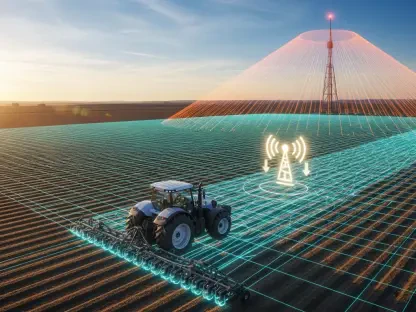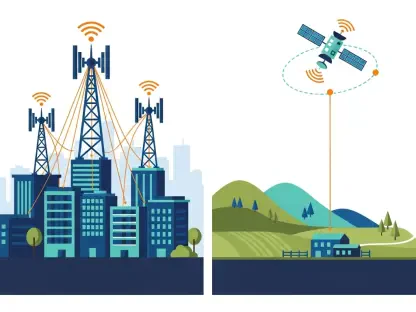The Global 5G RAN (Radio Access Network) Market is on the brink of a significant transformation, as the backbone of 5G network architecture, 5G RAN is essential for enabling mobile devices to connect to the internet and network core. With the market expected to grow from USD 3.5 billion in 2023 to USD 22.2 billion by 2033, the next decade promises substantial advancements and shifts in this sector. The expected compound annual growth rate (CAGR) of 20.3% from 2024 to 2033 highlights the increasing demand for high-speed internet and the global push towards digital transformation.
In 2023, the Asia-Pacific (APAC) region held a dominant position, securing over 41.8% of the total market share. This dominance can be attributed to the swift deployment of 5G networks in major economies such as China, South Korea, and Japan. These nations have robust government support and high urban population densities necessitating efficient network solutions, thus fueling the demand for 5G RAN.
Rapid Growth and Market Expansion
The rapid growth of the 5G RAN market can be seen in its compound annual growth rate (CAGR) of 20.3% from 2024 to 2033. This impressive expansion is driven by the escalating requirement for high-speed internet and the increasing emphasis on digital transformation across industries. With industries and consumers alike seeking faster and more reliable connectivity, the need for robust 5G infrastructure is paramount.
In 2023, the APAC region led the market by capturing over 41.8% of the total share. This leadership position arises from the quick rollout of 5G networks in major economies like China, South Korea, and Japan. Governments in these nations play a pivotal role in driving the deployments of 5G networks, further supported by the dense population in urban areas that increases the demand for efficient network solutions. The combination of government initiatives and market readiness in the APAC region makes it a key player in the global 5G RAN market.
Component Analysis: Solutions and Services
The division of the 5G RAN market into Solutions and Services components reveals that, in 2023, the Solutions component overwhelmingly dominated, capturing over 81% of the market share. These solutions are vital for enabling high-speed, low-latency communications, consisting of hardware and software elements such as antennas, base stations, and network management tools. Hardware components are crucial for the physical deployment of 5G infrastructure, while software solutions aid in the management and optimization of these networks.
Technological advancements in Massive MIMO (Multiple Input Multiple Output) and beamforming have significantly boosted the efficiency and capacity of 5G networks. These technologies aim to enhance the performance and reliability of 5G services, especially in densely populated urban areas. The growing trend towards virtualization and network slicing further revolutionizes the 5G landscape, allowing the creation of multiple virtual networks on a single physical infrastructure. This facilitates customized services for various sectors, addressing diverse user requirements and providing enhanced flexibility.
Architecture Type Analysis: CRAN, ORAN, and VRAN
Analyzing the market through different architecture types reveals that, in 2023, the CRAN (Centralized Radio Access Network) segment led with over a 35% share. CRAN is favored for its capability to centralize and consolidate network functions, thereby reducing operational costs and enhancing network management efficiency. This consolidation is particularly beneficial in urban areas requiring robust network support without extensive physical setups, making it ideal for high-capacity, low-latency applications.
The CRAN architecture supports critical technologies such as network slicing and virtualization, which are instrumental in managing multiple virtual networks simultaneously. This effective resource management addresses diverse network requirements, driving the demand for CRAN in various sectors. ORAN (Open Radio Access Network) and VRAN (Virtual Radio Access Network) are also crucial components of the market, with ORAN promoting network flexibility and interoperability among different vendors. This trend reduces dependency on specific hardware providers and encourages innovation through software-defined solutions.
Deployment Analysis: Indoor and Outdoor
When it comes to deployment types, the 5G RAN market is categorized into Indoor and Outdoor segments. In 2023, the Outdoor segment emerged as a leader, accounting for more than 58.6% of the market share. The prominence of the Outdoor segment is attributed to the necessity for robust outdoor connectivity in a variety of settings, from urban streets to rural regions, to support expansive network coverage. Enhanced mobile network coverage and capacity outdoors are crucial for industries like transportation and agriculture, facilitating real-time fleet tracking and precision farming operations.
Moreover, smart city applications heavily rely on continuous outdoor connectivity for efficient functions like traffic management and public safety monitoring systems. This necessitates the extensive deployment of dense 5G infrastructure in outdoor environments to ensure seamless connectivity and uninterrupted services. The demand for outdoor 5G solutions is therefore significant, driving the growth of this segment within the market.
End-use Analysis: Telecom Operators and Enterprises
In terms of end-use applications, the 5G RAN market is segmented into Telecom Operators and Enterprises. In 2023, Telecom Operators held the lion’s share, commanding over 80% of the market. The centrality of Telecom Operators in the rapid deployment and extensive coverage of 5G networks is undeniable. Their substantial investment in infrastructure to support advanced capabilities of 5G technology is crucial for providing enhanced mobile broadband services.
Telecom Operators play a pivotal role in the global digital transformation, offering the backbone infrastructure necessary for enabling remote working, cloud computing, and a dramatic increase in internet traffic. Applications such as ultra-reliable low-latency communications (URLLC) and massive machine-type communications (mMTC) further drive their market share, underscoring their vital position in the ecosystem. Enterprises, on the other hand, leverage 5G technologies for various operational improvements, including industrial automation, IoT integrations, and enhanced communication systems.
Regional and Geographical Insights
A regional and geographical analysis of the 5G RAN market reveals significant disparities in progress and market share. The APAC region stands out due to its rapid and substantial 5G network rollouts, driven by proactive government initiatives and major telecommunications companies in nations like China, South Korea, and Japan. These countries prioritize the enhancement of their telecommunications infrastructure, supported by a tech-savvy population that demands high-speed data services.
Other regions like Europe, North America, Latin America, the Middle East, and Africa show diverse levels of progress. These regions are characterized by significant investments, technological advancements, and collaborations among telecommunication entities to promote 5G deployment. Each region’s unique economic and regulatory environment influences the pace and extent of 5G adoption, contributing to the overall global landscape of 5G RAN development.
Market Drivers and Restraints
One of the primary drivers for the 5G RAN market is the expanding network infrastructure fueled by the increasing demand for high-speed internet and the global push towards digital transformation. These transformations necessitate substantial investments in developing 5G networks that can handle elevated data traffic, thus enabling new services essential for industrial automation and smart city projects. The demand for enhanced mobile broadband services and ultra-reliable low-latency communications (URLLC) further contributes to the growth of the 5G RAN market.
However, the market faces notable constraints, primarily due to the high costs and complexity associated with deploying 5G infrastructure. These factors can act as barriers, particularly in less developed regions where financial and technological resources may be limited. Integrating 5G technology with existing network frameworks presents additional technical challenges, complicating and potentially slowing down the adoption rate.
Opportunities and Challenges
The 5G RAN market presents various opportunities for growth and innovation. Continuous technological advancements, such as the development of Massive MIMO and new network equipment, promise to enhance 5G network capabilities further. Collaborative efforts among major industry players are also fostering robust and scalable 5G solutions, opening new business avenues in the media, entertainment, and IoT sectors.
Despite these opportunities, the market also faces significant challenges. Spectrum availability and regulatory issues pose substantial hurdles to 5G network deployments. Governments tightly control radio frequency allocation, and limited suitable spectrums can impede the deployment process. Compliance with local and international regulations for spectrum use adds another layer of complexity, varying significantly across countries and affecting the speed of 5G rollouts.
Growth Factors and Emerging Trends
Growth in the 5G RAN market is propelled by the escalating demand for high-speed internet and wireless services, driven by the proliferation of mobile devices and digital transformation across industries. 5G technology’s ability to significantly enhance data speeds and reliability fosters its adoption in sectors like autonomous driving, IoT, and telemedicine, thereby strengthening market demand. The ongoing expansion and modernization of telecommunications infrastructure to support 5G further catalyze market growth.
An emerging trend within the market is the shift towards Open RAN (ORAN), promoting network flexibility and equipment interoperability from various vendors. This trend reduces reliance on specific hardware suppliers and encourages innovation through software-defined network solutions. Integrating AI and machine learning technologies in 5G networks optimizes operations and improves traffic management, offering capabilities such as predictive maintenance and real-time analytics that enhance overall network performance.
Business Benefits of 5G RAN and Key Player Analysis
Deploying 5G RAN offers numerous business benefits, including improved network efficiency and capacity, which are crucial in data-driven environments. 5G RAN supports a wide range of new applications and services, creating new revenue streams for operators and businesses. It facilitates industrial automation by integrating IoT and AI technologies into factory operations, enhancing productivity and efficiency.
The 5G RAN market is highly consolidated, with key players driving competition through substantial R&D investments. Prominent companies like Telefonaktiebolaget LM Ericsson, Qualcomm Technologies, Inc., Nokia, Samsung, Huawei Technologies Co., Ltd., Intel Corporation, and Cisco Systems, Inc., play a vital role in innovating and enhancing 5G services and RAN capabilities. Strategic partnerships and expansions by some of these companies strengthen their market standing, while the competitive landscape accelerates advancements in the 5G RAN arena, positioning it as a critical domain for global tech leaders.
Recent Developments and Conclusion
Recent developments in the 5G RAN market highlight its dynamic nature. In October 2024, Telefonaktiebolaget LM Ericsson signed an agreement with Spain’s largest telecom operator, MasOrange, to upgrade its network using Open RAN technologies, marking Ericsson’s first Open RAN contract in Europe. In the same month, Du enhanced its collaboration with Nokia to expand 5G network capabilities, integrating advanced technologies for improved network services tailored to both individual and enterprise customers. Additionally, Software Radio Systems launched srsRAN Enterprise 5G, a full-stack software solution for private 5G networks built on an Open RAN architecture, facilitating rapid deployment in various computing environments.
The Global 5G RAN Market is poised for substantial growth driven by accelerating global 5G deployment, technological innovations, and increasing demand across various sectors. Strategic advancements by key players, combined with government and private sector investments, underline the market’s potential. Despite facing cost and regulatory challenges, opportunities in technological collaborations, and new applications across industries promise sustained market expansion. As 5G technology continues to evolve, the market dynamics are likely to see further transformation, positioning it at the forefront of global digital connectivity advancements.









